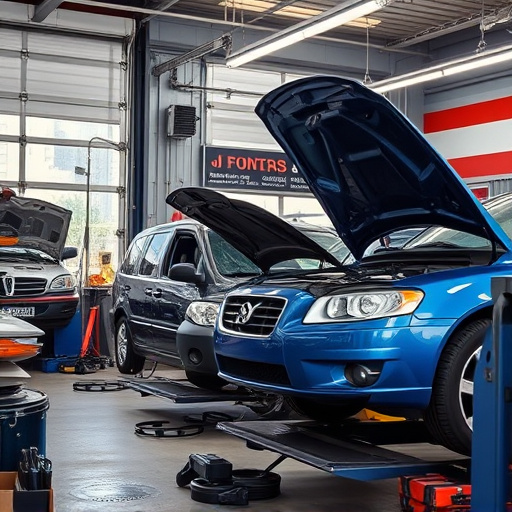Mastering TIG Welding for Electric Vehicle Frame Repairs After Collisions

TIG welding collision systems are indispensable for precise and efficient electric vehicle (EV) fram…….
In the realm of industrial manufacturing, precision and efficiency are paramount. TIG (Titanium-Gargen) welding collision systems have emerged as a game-changer, offering unparalleled control and accuracy in the welding process. This article aims to provide an in-depth exploration of these innovative systems, their impact on global industries, and the considerations shaping their future. By delving into history, technology, economics, policies, and real-world applications, we will uncover the multifaceted role of TIG welding collision systems in modern manufacturing.
TIG welding collision systems refer to advanced mechanical setups designed to enhance the precision and speed of TIG welding processes. These systems incorporate specialized hardware and software to enable automated or semi-automated welding, reducing human error and increasing productivity. At its core, a TIG welding collision system consists of:
The concept of collision in this context refers to the high-speed, controlled movement of the welding gun across the workpiece, creating seamless, strong welds. Historically, TIG welding was a manual process, requiring skilled technicians and hours of laborious work. The introduction of collision systems marked a significant shift, automating many aspects and reducing the time and effort required for complex welds.
The influence of TIG welding collision systems extends across industries and continents, driven by the increasing demand for precision manufacturing. Key trends shaping this global landscape include:
The global market for TIG welding collision systems exhibits a steady upward trend, driven by several economic factors:
| Factor | Impact |
|---|---|
| Increasing Manufacturing Complexity | As products become more intricate, the need for precise welding increases, fueling demand for advanced systems. |
| Quality Over Cost: In industries where product quality is paramount, TIG collision systems offer consistent results, justifying higher initial investments. | |
| Investment in Automation: Many manufacturers are embracing automation to enhance efficiency and reduce labor costs, positively impacting the market. | |
| Government Incentives: Some governments provide incentives for adopting advanced manufacturing technologies, boosting investment in TIG welding systems. |
The economic impact is further evidenced by:
Continuous technological leaps have elevated TIG welding collision systems to new heights of performance and versatility:
The development and deployment of TIG welding collision systems are guided by various policies and regulations, ensuring safety, quality, and environmental considerations:
Despite their numerous advantages, TIG welding collision systems face several challenges and criticisms:
Actionable Solutions:
Case 1: Automotive Industry – Tesla’s Advanced Welding Facility
Tesla, the electric vehicle pioneer, has implemented TIG welding collision systems at its Gigafactories to achieve unparalleled precision and consistency in battery casing and chassis welds. The company’s focus on quality and innovation has resulted in reduced assembly times and improved structural integrity of its vehicles. This case highlights how advanced welding technologies contribute to the overall efficiency and performance of modern EVs.
Case 2: Aerospace – Boeing’s Precision Welding Initiative
Boeing, a global aerospace leader, has embraced TIG collision systems to join composite materials in aircraft structures. By automating the welding process, Boeing ensures consistent quality across its fleet, reducing weight and fuel consumption. This strategy aligns with the company’s commitment to sustainable aviation, showcasing how TIG welding enhances both efficiency and environmental performance.
Case 3: Shipping Industry – Container Welding Innovation
In the maritime industry, a leading manufacturer of shipping containers adopted TIG collision systems to automate the often labor-intensive process of joining container panels. The result was a significant increase in production capacity and reduced lead times for delivering containers to ports worldwide. This case study demonstrates the versatility of TIG welding in diverse manufacturing sectors.
The future of TIG welding collision systems looks promising, with several growth areas and trends on the horizon:
TIG welding collision systems have emerged as a cornerstone in modern manufacturing, offering unparalleled precision and efficiency across diverse industries. From automotive and aerospace to shipping and emerging sectors, these systems are revolutionizing welding practices. As technology advances and global trends evolve, TIG collision systems will continue to play a pivotal role in shaping the future of manufacturing, ensuring high-quality, consistent outcomes while driving operational excellence.
Q: What are the key benefits of using TIG welding collision systems?
A: These systems offer improved precision, reduced welding times, and enhanced productivity compared to traditional manual methods. They also ensure consistent quality, reduce material waste, and lower operational costs in the long run.
Q: How do TIG collision systems handle complex weld geometries?
A: Advanced motion control algorithms and real-time feedback systems enable these systems to accurately weld intricate shapes and contours, ensuring precise results even on challenging workpieces.
Q: Can TIG welding be used for all types of materials?
A: While TIG welding is versatile, not all materials are suitable for it. Some non-ferrous metals and certain composite materials may require specialized settings or pre-treatment to achieve successful welds. Material testing and optimization are essential for best results.
Q: How do I ensure the longevity of my TIG collision system?
A: Regular maintenance, including cleaning, lubrication, and part replacement, is crucial. Following manufacturer guidelines and staying updated with firmware updates will also contribute to the system’s lifespan. Proactive monitoring through remote diagnostics can help anticipate potential issues.
Q: Are there any environmental advantages to using TIG welding collision systems?
A: Absolutely! These systems promote more efficient material use, reduce waste, and lower energy consumption compared to some alternative welding methods. This contributes to a smaller carbon footprint and aligns with sustainable manufacturing practices.

TIG welding collision systems are indispensable for precise and efficient electric vehicle (EV) fram…….

TIG welding collision systems are in high demand across multiple industries for their versatility an…….

TIG welding collision systems revolutionize auto repair with precise, versatile GMAW technology. Ide…….

TIG welding collision systems offer advanced, precise auto damage repairs, especially for complex st…….

TIG welding collision systems transform automotive repair with precision, speed, and cost-efficiency…….

TIG welding collision systems are advanced tools enhancing modern auto body repair with precise, rel…….

TIG welding collision systems revolutionize car bodywork repair by offering precise, corrosion-resis…….

TIG welding collision systems integrate precision TIG welding with CAD and sensor technology to rest…….

TIG welding collision systems enhance precision and efficiency in panel fabrication, ideal for auto…….

TIG welding collision systems excel in precise, intricate automotive frame restoration, offering sup…….